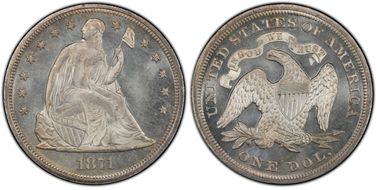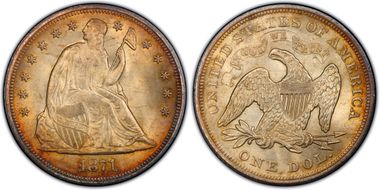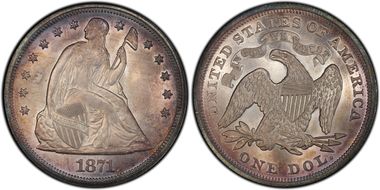1871 $1 XF40 认证号34652008, PCGS号6966
专家评论
Q. David Bowers
The following narrative, with minor editing, is from my "Silver Dollars & Trade Dollars of the United States: A Complete Encyclopedia" (Wolfeboro, NH: Bowers and Merena Galleries, Inc., 1993).Coinage Context
Distribution: While many 1871 Liberty Seated dollars probably were exported to China, the mintage was so large that pieces are common today. It is likely that large numbers remained stateside in Treasury vaults and were released into circulation beginning in autumn 1876, when specie payments were resumed. Some were returned to the Treasury, bagged, and not released until 1962-1964. The 1871 Liberty Seated silver dollar was the first with a mintage to cross the million mark, and was just one of two dates to achieve this level, the other being 1872.
Numismatic Information
Circulated grades: Of all Liberty Seated dollars, the 1871 is the most available date today. Examples are readily available in VF, EF, and AU grades and make ideal candidates for inclusion in a type set to illustrate the 1866-1873 Liberty Seated design with the motto IN GOD WE TRUST on the reverse.
In 1963, when James F. Ruddy and I had the enjoyable experience of sorting through quantities of circulated Liberty Seated dollars obtained from the Federal Reserve during the great Treasury distribution, we found many 1871 dollars. These were nearly all in VF and EF, with light brown-gray toning.
Mint State grades: Although Walter H. Breen in his Encyclopedia of United States and Colonial Coins states that two bags (2,000 coins total) of Uncirculated specimens were released by the Treasury in 1962-64, my experience concerning the availability of Mint State pieces does not confirm this, although there are indeed at least a couple hundred or more Mint State coins extant. (The information in the Encyclopedia is probably erroneous, and may have derived from Ron Severa (below). Walter H. Breen, in a letter dated February 12, 1992, asked me to verify these bags with Harry Forman. Upon endeavoring to do so, I learned that Harry Forman handled at the most a few dozen Uncirculated pieces. In an article, "Liberty Seated Dollars - Scarcity / Availability," in The Gobrecht Journal, March 1977, Ron Severa stated: "Two bags released by Gov't." For dollars of 1859-O and 1860-O he wrote that one bag each was released. For 1872 dollars he simply stated, "Available in most listings," and did not mention government hoards.)
I have seen a few Mint State coins with lightly etched surfaces, said to have been retrieved from a shipwreck of unknown location and details.
Bruce Amspacher stated in 1982 that Mint State 1871 dollars were offered regularly and by the roll on the Teletype and stated that "in fact, they are flooding the market." (Article, "Liberty Seated Dollars," in the Monthly Summary, Coin Dealer Newsletter, July-August, 1982.) Recently, Bruce Amspacher wrote the following letter concerning the situation: (Letter to the author, datelined 2 a.m. (!), June 24,1992.)
I need to explain something. In 1982, I wrote a series for Coin Dealer Newsletter about Liberty Seated dollars. You have quoted it many times in your book. Thank you. However, what I wrote about the 1871 Seated dollar was meant as sarcasm. Unfortunately, it has been quoted elsewhere as gospel. Here's what happened:
In 1982 I was having a continuous verbal war with the press, both numismatic and non-numismatic. They were running a series of articles that I thought were extremely negative. The thrust of the articles was that coins were overpriced and dealers were all crooked and coins weren't really rare, etc. At least that was how I interpreted them. In fairness to the press, I was in a constant state of agitation about many things back then, so I'm sure I would react differently today - if I reacted at all. Anyway, I was poking fun at the press in the Liberty Seated dollar article I wrote. I don't have a copy of the article in front of me, but I said something like this: "1871 Seated dollars are common in gem condition. Original rolls are offered on the teletype every day. In fact, they are flooding the market.
Unscrupulous dealers actually try to tell people that they're rare. Oops, excuse me. For a moment there, I thought I was writing an article for The Wall Street Journal."
I'm really sorry I ever wrote these words. The "humor" failed completely, my intent was misinterpreted, and even today those lines reach out of the past and bite me now and then. So .... I hope I've cleared that one up.
Upon rereading my Adventures With Rare Coins book, published in 1979, p. 98, I came across this statement: "A bag of 1871 Uncirculated silver dollars came to light and was purchased intact by an investor who, as of this writing, still has it." I considered the news to be reliable at the time. However, later I received information from an individual who examined the inventory of the investor (a prominent Eastern rare coin dealer) in question, and I was told that the firm never had such a bag.
While Mint State coins are not rarities, their availability cannot in any way be compared to, for example, the 1860-O, the latter being offered frequently on the market. If it were not for the bag of 1,000 coins I mentioned in my 1979 book, I would say today that it is my opinion that several hundred Mint State 1871 dollars were released by the Treasury during 1962-1964, probably mixed in with other coins. I have not been able to confirm the existence in the 1960s or now of any full bags.
Silver source note: Just as swords were beaten into plowshares in antiquity, in 1871 some melted down silver trumpets used by Philadelphia's Diligent Fire Engine Company Co. 10 were the source for bullion to make Liberty Seated dollars, both circulation strikes and Proofs.
Pattern commentary: The Mint directorships of James Pollock (May 1861 to September 1866 and again May 1869 to March 1873) and Dr. Henry Richard Linderman (April 1867 to April 1869 and again from April 1873 to December 1878) were times of free-for-all activities in the coiner's department. Large numbers of unnecessary patterns were struck.
The Standard Silver coinage (as noted earlier, this term is not to be confused with the standard silver dollar; STANDARD was a description used on the reverse of certain pattern 10¢, 25¢, 50¢, and $1 pieces intended to be made of lower weight to redeem Fractional Currency notes) in particular was abused, and needless variations were made in these combinations, each in sets similar to those of 1869:
1. Silver with plain edge.
2. Silver with reeded edge.
3. Copper with plain edge.
4. Copper with reeded edge.
5. Aluminum with plain edge.
6. Aluminum with reeded edge.
Certain pattern dollars of 1870 and 1871 were denominated STANDARD 1 DOLLAR. Cf. Dr. J. Hewitt Judd, United States Pattern, Experimental and Trial Pieces for details.
Limited numbers of "trial strikes" were made of regular Proof dies, including Liberty Seated dollar dies, in other metals; these were not openly sold. Thus, collectors with the right connections could obtain Proof sets of certain years, complete from the Indian cent through the $20, struck in aluminum or copper. Few records were kept of such pieces produced.
The point of mentioning this here is that regular Proof mintages (such as for Proof Liberty Seated dollars of the normal design) may or may not be accurate. There is no evidence to suggest that Mint figures for Proof dollars are wrong, but it is worth noting that the possibility exists.
Varieties
Circulation strikes:
1. Normal Date: Breen-5487. Obverse: With 7 and 1 in date nearly touching. The most plentiful variety. Many minor varieties occur among obverse date positions, but these have never been classified.
2. Normal Date: Breen-5488 Obverse: With 7 and 1 farther apart than preceding. Apparently scarcer.
Dies prepared: Obverse: 1; Reverse: 1 (estimates)
Circulation strike mintage: 1,073,800; Delivery figures by day: January 12: 8,000; January 13: 15,000; January 17: 15,000; January 23: 16,000; January 30: 16,000; February 3: 10,800; February 10: 15,000; February 21: 12,000; March 1: 14,000; March 11: 12,000; March 14: 12,000; March 15: 500; March 16: 9,000; March 21: 16,000; March 24: 14,000; March 28: 14,000; March 29: 10,400; April 12: 10,000; April 13: 7,700; April 17: 10,000; April 18: 10,000; April 19: 8,800; April 26: 10,000; April 28: 23,500; May 5: 8,900; May 9: 16,800; May 18: 12,000; May 20: 12,000; May 27: 10,000; June 2: 10,000; June 5: 16,800; June 10: 13,00; June 15: 10,000;June 17: 12,400;June 30: 12,000; July 5: 9,000; July 8: 24,000; July 10: 12,000;July 12: 19,000;July 13: 12,000;July 15: 6,000; July 20: 20,000; July 21: 22,000; August 4: 17,000; August 9: 20,000; August 11: 26,000; August 18: 17,700; August 24: 22,000; September 22: 12,000; September 25: 12,000; September 27: 12,000; September 28: 12,000; October 2: 12,000; October 5: 12,000; October 6: 12,000; October 9: 12,000; October 13: 12,000; October 17: 12,000; October 19: 20,600; October 30: 15,000; November 1: 8,000; November: 7,600; November 9: 12,000; November 10: 12,000; November 13: 12,000; November 14: 9,000; November 16: 15,000; November 17: 19,300; November 21: 12,000; November 22: 12,000; November 23: 12,000; November 24: 13,800; November 27: 4,000; December 2: 12,000; December 4: 10,500; December 8: 8,000; December 11: 13,000; December 13: 20,400; December 16: 7,000; December 20: 6,000; December 22: 5,000; December 26: 24,000; December 29: 13,300.
Estimated quantity melted: Unknown
Characteristics of striking: Striking quality varies; some show weakness.
Known hoards of Mint State coins: At least several hundred were released by the Treasury Department in 1962-1964; additional pieces were recovered from an unknown shipwreck, "seawater Uncirculated," with porous surfaces.
Commentary
This is the most common circulation strike date in the later Liberty Seated dollar series, 1866-1873 with IN GOD WE TRUST on the reverse.
Wage Indexes From 1871 to Date
To appreciate why collectors did not save Liberty Seated, Morgan, and other silver dollars in quantity at the time of their issue, it is interesting to reflect upon figures compiled by the United States government and published in the Statistical Abstract.
In 1871 the average annual wage in America was $415, rising to $418 in 1872 and falling back to $401 in 1873. During the next decade the average annual wage remained lower and did not reach $418 again until the year 1900. Inflation, as a later generation of Americans was to know it, did not exist.
In 1910 the average wage was $575, climbing to $1,340 in 1920, $1,420 in the peak year of 1929, $1,390 in 1930, and then falling back to a low of $1,040 in 1933. The average wage then began to climb, reaching $1,310 in 1940, $2,820 in 1950, $4,190 in 1960, $6,230 in 1970, $12,200 in 1980, and $18,000 in 1990.
In 1871 the average hourly wage was 14 cents. According to government statistics, from 1877 through 1880 inclusive it dropped to 11 cents. By 1900 it was 15 cents, 1920 53 cents, 1940 65 cents, 1960 $2.09, and 1990 $10.03.
To convert the value of a dollar in 1871 to its equivalent value in 1991, one multiplies by 72.3. In other words, the value of an 1871 Liberty Seated dollar to the average American wage earner in 1871 was roughly equivalent to what $72.30 would have been worth to the average American wage earner in 1991. It is no wonder that relatively few silver dollars were saved in Proof or any other preservation at the time of issue. In 1871, American society was much more stratified than it would be a century later. Only the wealthy could afford to collect silver dollars by date sequence, even if they obtained them for only face value. With the average working man having a wage of $8 per week (women working in textile mills were more apt to earn about $5 or $6 per week), it was all the average citizen could to do find enough money to feed and clothe a family.
The multiplier for the year 1878, when the Morgan silver dollar was introduced, is 94.5, meaning that what was the value of a newly minted Morgan dollar to someone in 1878 was equivalent to $94.50 to an American wage earner in 1991. In terms of relative buying power, to set aside a newly-minted 1878 dollar as a souvenir in the time of issue was like spending $94.50 on a newly-issued coin in 1991.
By the end of the early Morgan series in 1904 the multiplier was 61.2. At the beginning of the Peace series in 19.21 the multiplier was 20, and at the end of the early Peace series in 1935 the multiplier was 18.2. If the hourly wage index is used, the multiplier for 1971, the first year of the Eisenhower dollar, is 3.01, meaning that by 1991, the year the present index was compiled, the average wages were 3.01 times higher.
PCGS #
6966
设计师
Christian Gobrecht
边缘
Reeded
直径
38.10 毫米
重量
26.73 克
铸币数量
1074760
金属成分
90% Silver, 10% Copper
更高评级数量
880
评级较低的钱币数量
627
地区
The United States of America
价格指南
PCGS 数量报告
拍卖 - PCGS 评级的
拍卖 - NGC 评级的
稀有性和存量估计 了解更多
| 所有评级 | 3000 |
| 60或以上 | 300 |
| 65或以上 | 7 |
| 所有评级 | R-4.4 |
| 60或以上 | R-6.4 |
| 65或以上 | R-9.6 |
| 所有评级 | 14 / 15 |
| 60或以上 | 14 / 15 |
| 65或以上 | 9 / 15 |
| 所有评级 | 37 / 45 TIE |
| 60或以上 | 42 / 45 |
| 65或以上 | 26 / 45 TIE |























